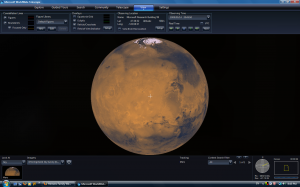Astrobites is again liveblogging AAS! In order to avoid inundating our readers’ RSS feeds, we’ll be updating this post with short paragraphs about the talks we’ve heard and posters we’ve seen. So keep checking back throughout Tuesday morning!
-The Astrobites Team
Monday Afternoon Posts
Monday Morning Posts
10:00am – Innovations in Teaching, Learning, and Mentoring
This particular session took a step back from strictly science to examine how we teach and mentor and how students learn. There were eight speakers talking about a variety of topics but one of the main take away points was technology, technology, technology. Patricia S. Udomprasert discussed new interactive 3D simulations from the World Wide Telescope to help students understand geometrically complex problems like the phases of the moon, while William S. Burgett discussed the International Astronomical Search Collaboration, a free program through which middle and high school students can discover new asteroids in survey images PanSTARRS. Once they are confirmed the students even get to name their discoveries! Suketu P. Bhavsar discussed ways to effectively implement a hybrid (part on-line, part in-class) astronomy course, by guiding students through learning the course content on-line and reserving the weekly face-time for discussion. On the mentoring side of things both Emily Levesque and Shouvik Bhattacharya discussed different programs developed to ensure undergraduate students are aware of and well prepared the multitude of career paths available to them with a bachelors degree in physics or astronomy. Finally, the session also included the announcement of a new study to examine how young students achieve a conceptual understanding of astronomy (CAPER), a program to train new middle and high school student teachers with astronomy curriculum material (GEMS), and the development of a new test to assess how well introductory students understand basic concepts related to optics (the Physical Optics Concept Inventory).
10:30am Press Release: Exoplanet Systems from Birth to Death
The exciting announcements from yesterday’s exoplanet press conference about planet statistics tell us that most main sequence stars have planets. This morning, the press conference was about planets around more exotic evolved stars. Ben Zuckerman announced evidence for a planetary system around a white dwarf in the Hyades star cluster; they found this evidence by looking for ‘pollution’ from a planet being accreted onto the start. John Debes also looked at white dwarfs, finding evidence for gas disks around such polluted white dwarfs. Alex Wolszcan gave an update about planets around neutron stars (if you remember exoplanet ancient history, the first planet was found around a pulsar way back in 1989!). Finally, Jay Pasachoff showed observations from a much less exotic system—our own solar system! He showed observations of the transit of Venus this past June as observed from Hawaii, from solar spacecrafts, and—incredibly—reflected off of Jupiter and from the Cassini mission currently at Saturn.
11:40am – Cannon Award: Exploring the Diversity of Exoplanetary Atmospheres
Heather Knutson was recently awarded the Annie Jump Cannon award for her ground-breaking work on exoplanetary atmospheres. This morning she gave an excellent talk, which addressed how we characterize these atmospheres and the patterns that are already emerging. Detailed characteristics may be studied using the Spitzer Space Telescope, where infrared observations are ideal because the planet is much brighter in the infrared (leading to a greater transmission depth) and molecular bands are more present at these wavelengths. Most Hot Jupiters orbit very close to their host stars, meaning that they are tidally locked. As such they are likely to have a day and night side. The difference between the two sides is characterized by 1) the radiative timescale, which is set by the atmospheric opacity and 2) the advective timescale, which is set by the atmospheric wind speed. Early results show a simple pattern: cool Jupiters tend to show a large deviation between the day and night side temperatures, while hot Jupiters tend to show no deviation between the day and night side temperatures. Of course we need to expand our sample by including low mass planets around cool stars. Heather finished her talk by noting that it is important to not focus on what you expect to find, and always keep an open mind. The field is exoplanetary research is full of surprises!


Trackbacks/Pingbacks